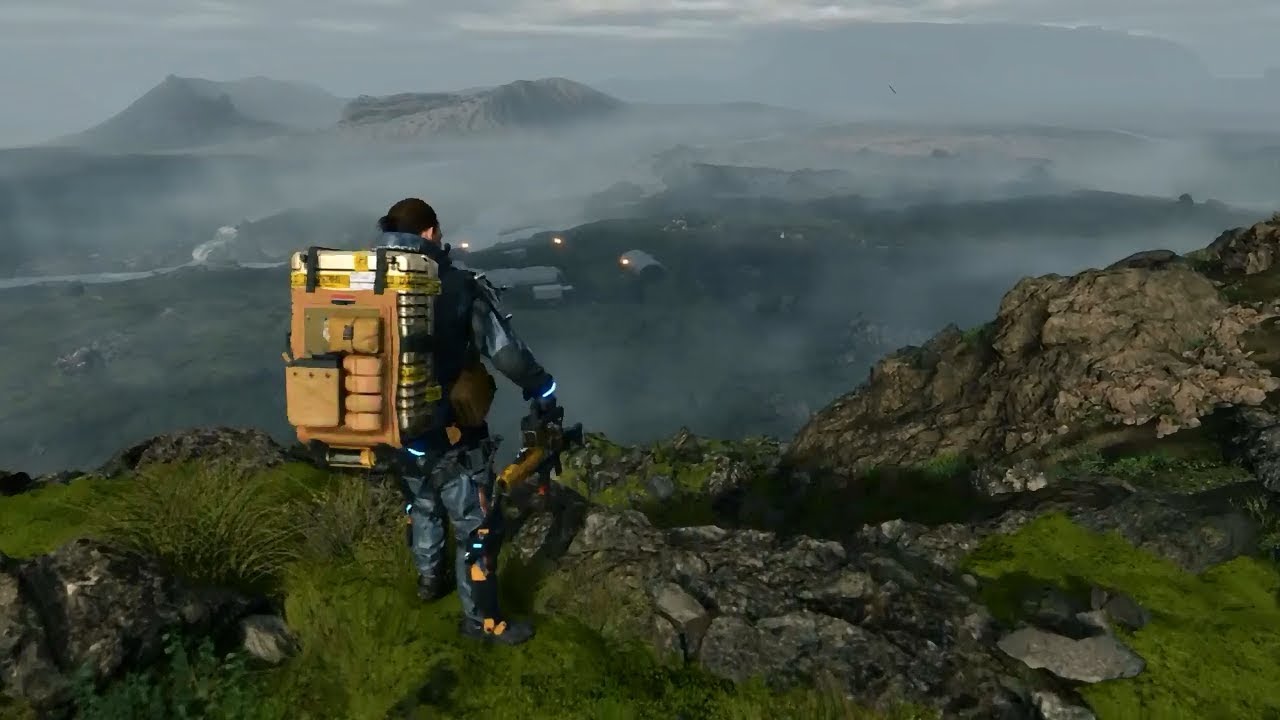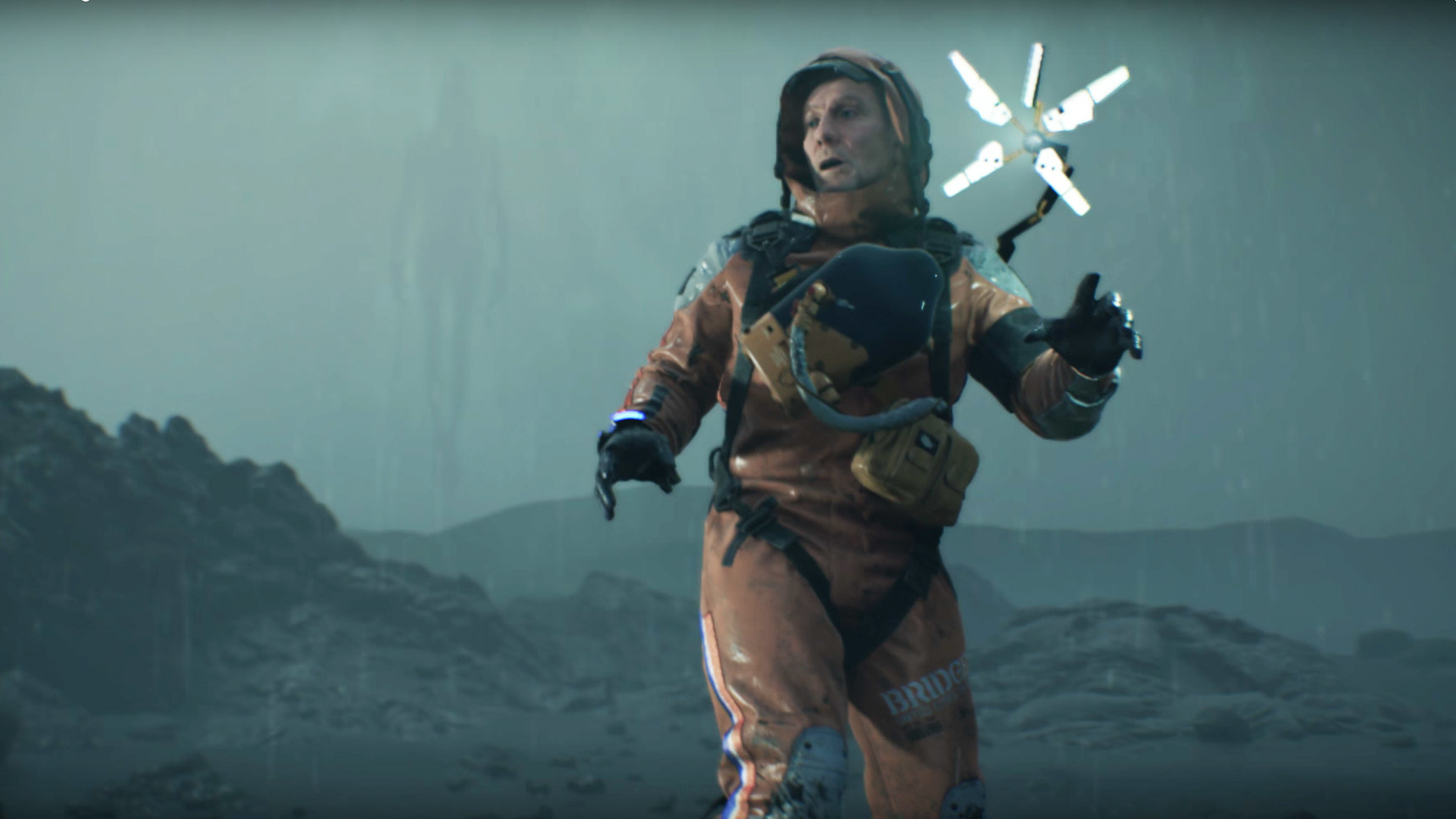I have seen Death Stranding at Gamescom, and I think I finally understand what the fuck is going on. Here's the thing, it can be all too easy to lose sight of a universal truth: every game starts as a simple concept. That's true of every single video game in the industry – yes, even those with Hideo Kojima at the helm.

Almost anyone who visited Kojima Productions is probably going to be in Death Stranding
As inherently political, purposefully obscure, and undoubtedly metaphysical as his games are, each of them has an idea that is easy to understand at the heart of them. That was true of Snatcher. That was true of Boktai: The Sun Is In Your Hands, Metal Gear, Policenauts, and what little we were lucky enough to see of Silent Hills through the lens of P.T. – may it rest in peace. Oh, and guess what, it's true of Death Stranding as well.
You have to cut through a lot of bullshit to find it, but it's there, nestled behind the messy themes of motherhood he seems so intent on exploring. To understand Death Stranding – the intent behind its narrative and the type of game that it is trying to be – you need to forget about the BBs, BTs, and strangely captivating urination systems.
Forget the famous faces with unfamiliar voices, and the whirlwind of conflicting science-fiction tropes wrestling for your attention at any one given moment in time. Hideo Kojima has long attempted (somewhat unsuccessfully) to explain that Death Stranding was a game about connection, and it has taken a new behind-closed-doors demonstration finally gave me a clear idea of the intent behind his laboured explanations.
Death Stranding is actually about connection

The thing that really stood out to me was just how simple this game is at its core. Death Stranding is a game about walking. As Sam Porter Bridges (or as you probably know him, Normal Reedus trapped in the uncanny valley), you are tasked with walking from the East coast of America to the West, reactivating various communication nodes along the way in an effort to spread a message of hope to a nation that has become fragmented and disconnected, taking the idea of unity to pockets of an isolated populous that trades in ambivalence rather than love. That is Death Stranding.
And so you will walk. You will retrace the steps of Amelie, daughter of the President of the United Cities of America, who embarked on her own East to West journey with a convoy sometime before the game kicks into gear. She did this in an attempt to establish a network of communication relays across the country, a network that could deliver a message of unity from her mother, Bridget, who also happens to be on death’s door. That message is that every problem in the world needn't be solved by force; instead, it is hope that can bring us all together.
This is necessary after Central Knot City was destroyed in a terrorist attack – through the use of irresponsible 'Void Outs', the act of coming back from the 'Other Side', from the game's central antagonists. This has pushed pockets of civilisation to disconnect themselves from the government and from each other in fear, choosing to instead go it alone in the wildlands.
Sign up to the GamesRadar+ Newsletter
Weekly digests, tales from the communities you love, and more

Off on the edge of the Pacific is Edge Knot City, home to a group being painted as a decentralised force – separatists and terrorists, the Homo Demens – who are intent on ensuring their own independence. It's on the road to Edge Knot City – on the road to building a bond with the most dangerous and disconnected portion of this vision of a fractured America – where Amelie was captured; she appears to Sam as a hologram projection in everything that we have seen so far, never ageing, looking to him as she did on "back on that beach". She's safe, she tells Sam, and she's free to talk to him and use the facilities as much as she likes – she isn't in a prison, she is keen to note – she just isn't able to leave the confines of Edge Knot City.
Connect the country up to the communication network, see if you can rescue Amelie from the Homo Damens and their leader, Higgs – the 'Man in the Golden Mask' played by Troy Baker – and spread the message of a dying president to halt the otherwise irreversible fracture of society. There's your story in Death Stranding; it's no more confusing than that. It's the drive to get you moving through the world and the core tenant to the gameplay.
The rest of it is all noise – a collection of gamification and esoteric sci-fi concepts to introduce conflict. Death Stranding is a game about a pilgrimage, about activating communication relays, and about delivering parcels to isolated corners of America in an attempt to establish social strands – building bonds with your fellow man in an effort to inspire hope in a dying society.
I know about Sam's necklace

I know that we've all had a great deal of fun with the Death Stranding theories, trying to work out what Sam's necklace is and what it might represent. It's an intriguing mystery, isn't it? A necklace made of six tags, each inscribed with various equations – a device that seems to defy gravity at times; how exciting.
It turns out this necklace is a Q-PIP, assigned to Sam by Die-Hardman – the gentlemen seen wearing a black face mask in the trailers – in a behind-closed-doors video that establishes the story and setup of the game. That necklace is a security key. Not, like, a cool key that disrupts the fabric of time or alters reality through Einstein equations as we've been rampantly speculating for months, but an actual key. You know, the kind of key that postmen carry around with them to unlock postboxes.
Yep, the Q-PIP is used to unlock the Cryon terminals – the communication relays out in the world that have been taken offline. The idea here is that Sam is to connect each of the terminals to the overall network from their respective station's control panel, which will then create a bond or, you know, a strand. Connect the terminal to the network, and the United Cities of America can extend the reach of its message a little further and, in step, attempt to rebuild connections amongst the nation. Think of Sam as an engineer that has been assigned by the US government to slowly cross the country to repair damaged phone lines, all in an effort to better transmit a core political message to literally and figuratively connect the nation back together.

Think of Sam as an engineer that has been assigned by the US government to slowly cross the country to repair damaged phone lines
As you establish these connections, you can pull open the map and track your progress across the country. There's a clear radial spray denoting how much of an area has been marked following its connection to the network. Meters pop up to show the strands you have made with other NPCs as you complete fetch quests for them, delivering them their mail.
To be honest, after seeing this section of the game, I'm not entirely unconvinced that this isn't a game built around the synchronization viewpoints of Assassin's Creed, or the lighting of the beacons in The Lord of the Rings. The best way to visualise these systems is to consider what happens to the map in any of the Assassin's Creed games once you scale a tower, take in the view, and get assaulted by a battery of waypoints.
When you zoom this far out, Death Stranding looks palatable. It isn't a collection of random concepts bridged by Kojima's friendships in Hollywood, but a game with a simple idea and a simple message. That's a good thing, because, all told, we actually know very little about the game, and that is a little terrifying given that the Death Stranding release date is set for November 8.

We don't really know how navigation and traversal are going to work, outside of understanding that there is a ladder that materialises out of thin air and can bridge impossible spaces. We have no real grasp on what the combat mechanics will be like; Kojima maintains that it isn't a stealth game, but we haven't seen anything to the contrary.
We don't know how the online elements will work, aside from players being able to asynchronously urinate in the same spot to spawn gross mushrooms. We also don't know all that much about the Other Side or the demonic enemies crashing through into this reality – tethered to another plane of existence by thick, black umbilical cords.
And we definitely don't know why Kojima seems so intent on building narrative threads around decaying babies in utero. But we do know that there will be a lot of walking, a lot of activating points-of-interest, a lot of fetch quests, and a simple narrative throughline that is easy to grasp. All things considered, that's enough for me.
For more, check out the best Death Stranding theories we've seen so far, or watch the video below for a look at the title's recent gameplay demo from Gamescom.

Josh West is the Editor-in-Chief of GamesRadar+. He has over 15 years experience in online and print journalism, and holds a BA (Hons) in Journalism and Feature Writing. Prior to starting his current position, Josh has served as GR+'s Features Editor and Deputy Editor of games™ magazine, and has freelanced for numerous publications including 3D Artist, Edge magazine, iCreate, Metal Hammer, Play, Retro Gamer, and SFX. Additionally, he has appeared on the BBC and ITV to provide expert comment, written for Scholastic books, edited a book for Hachette, and worked as the Assistant Producer of the Future Games Show. In his spare time, Josh likes to play bass guitar and video games. Years ago, he was in a few movies and TV shows that you've definitely seen but will never be able to spot him in.


